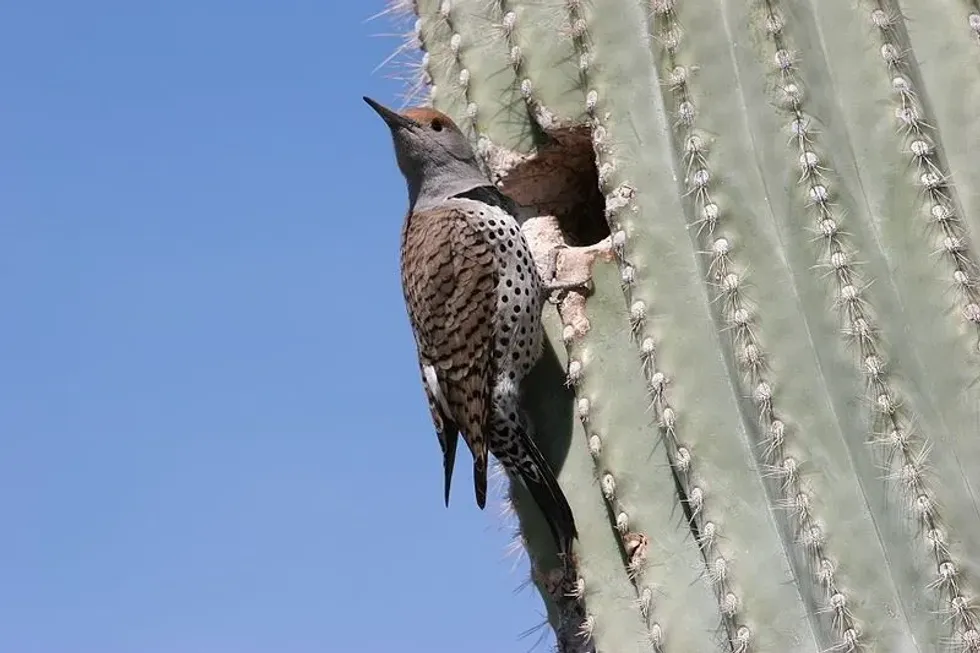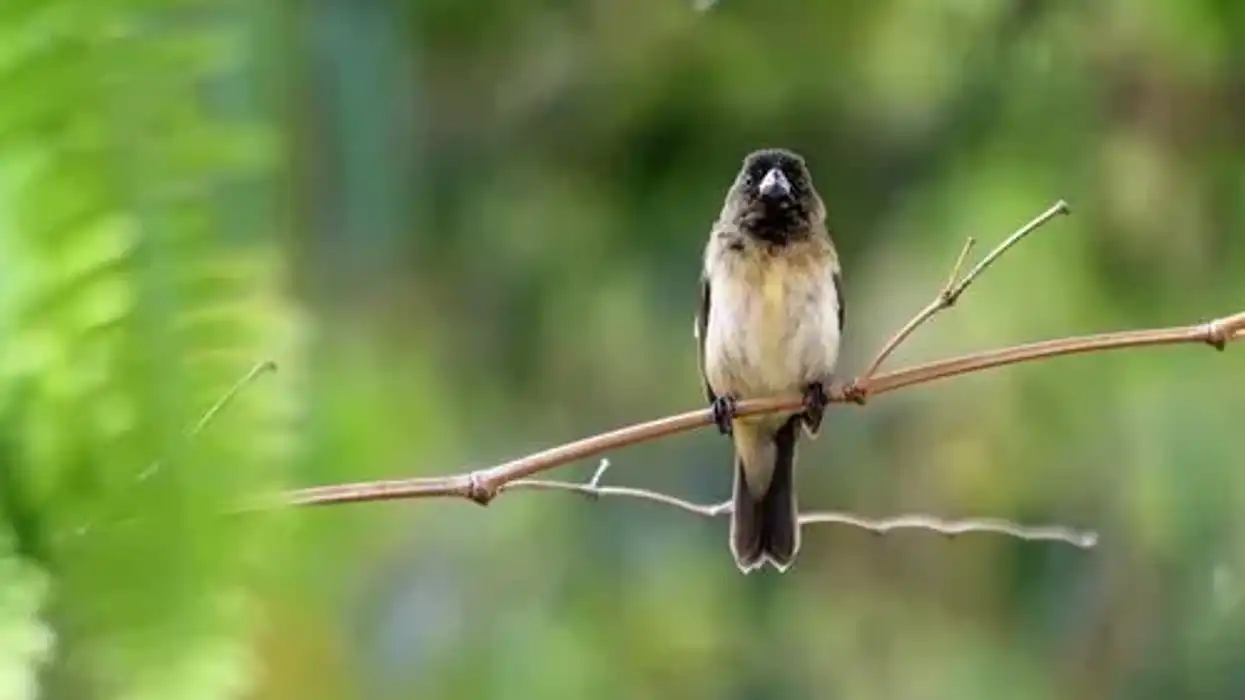The Gilded Flicker (Colaptes chrysoides) is a medium-large-sized bird that is often confused with woodpeckers. The Gilded flicker birds of North America are very similar in resemblance to the red-shafted Northern flickers. The habitat of these North American birds is mainly the Sonoran desert, Arizona and Baja, and California.
They inhabit the giant saguaro cactus where they nest. They are aggressive and territorial. However, there is no threat to these birds and they are found in abundance in their range.
The Gilded Flicker is a cute colorful bird with an overall brown plumage with black spots. The wings turn spectacularly golden as the bird spreads its wings for flight.
The Gilded flickers are generally wild birds, but they can also be attracted into the woodland backyards. A Gilded flicker symbolizes growth and advancement. Flickers, in general, are named so because the brilliant and beautiful feathers resemble the flickering of the flames when the bird spreads their wings to take flight.
If you like this article, also check out pileated woodpecker and ivory-billed woodpecker facts.
Gilded Flicker Interesting Facts
What type of animal is a Gilded Flicker?
A Gilded flicker is a woodpecker endemic to the Sonoran deserts. It is also known as the yellow-shafted flicker. It is a large and aggressive bird. It primarily forages on the ground but is a beautiful bird in flight with golden yellow underwings.
The bird belongs to the Picidae family, order Piciformes. The birds build their nest in saguaro cacti. The nest site is also excavated in dead tree trunks, not three meters in height.
What class of animal does a Gilded Flicker belong to?
The Gilded Flicker (Colaptes chrysoides) belongs to the Aves class. It is of the order Piciformes, family Picidae. The species is categorized into four recognized subspecies. They are Cape gilded flicker, Brown gilded flicker, Mearns’ gilded flicker, and Mexican gilded flicker.
How many Gilded Flickers are there in the world?
The exact count of these birds is not available. But from what is known about these birds, they are found in abundance in their natural habitat. Therefore, the IUCN Red List status of this bird is Least Concern.
Where does a Gilded Flicker live?
A Gilded Flicker is endemic to the Sonoran Desert of North America. They are also found in the large saguaros of Arizona and Baja, California. In addition, the yellow-shafted flicker dwells in the giant cactus forests. The birds are found in the Sonoran, Yuma, and eastern Colorado Desert regions of the southwestern United States and also northwestern Mexico.
What is a Gilded Flicker’s habitat?
A Gilded flicker is commonly found in the wooded areas of the desert forests. They inhibit the giant saguaro cactus where they nest.
Instead, they perch on trees at height. The bird is found along the riverside groves. At low elevations, they can be seen foraging in the groves of cottonwoods and other trees along the streams in the desert woodlands.
Who do Gilded Flickers live with?
Gilded flickers prefer to live on their own in pairs. However, they are very protective and possessive about their mates and show aggression when another bird is found in the vicinity. They are seen foraging on the ground and perching on the top of the giant cactus and trees.
How long does a Gilded Flicker live?
The exact data on the lifespan of the Gilded Flicker is not known. But the Northern flickers, the red-shafted one, can live for about nine years in the wild, and this data is assumed comparable.
However, with the improvement in the study and research on this yellow-shafted bird, the oldest recorded Gilded flicker is six years and four months in Arizona.
How do they reproduce?
A Gilded flicker reproduces by the sexual reproduction process. The species is monogamous and mates for their lifetime. Both male and female birds are protective and possessive about their mates.
The species breed between May and July. The birds build their nest in saguaro cacti and dead trees and trunks. The male initiates the process of digging the cavity for nesting, wherein the female joins later.
Three to six eggs are laid per brood, and there can be two broods in a season. Both parents incubate the eggs for around two weeks.
The hatchings are helpless at birth and are vulnerable to predators. It takes about a month for the hatching to molt. The fledglings stay around the nesting site for another month or so before flying off.
What is their conservation status?
According to the IUCN Red List, the conservation status of the Gilded Flicker (Colaptes chrysoides) is ‘Least Concern’. The species are found in abundance in their habitat, and there is no major threat to their population. Of course, they are losing their habitat because of human activities, but at present, it is not a thing to worry about.
Gilded Flicker Fun Facts
What do Gilded Flickers look like?
The Gilded Flicker has a tan crown with a gray face. They have a black bib that is oval and a white rump.
The belly has black spots all over. Male birds have a distinguishable red mustache stripe. The brown plumage is visible when the bird is perched, but you can notice bright yellow undersides of the wings and tail feathers in flight.
How cute are they?
The Gilded Flicker is a cute colorful bird with an overall brown plumage with black spots. The wings turn spectacularly golden as the bird spreads its wings for flight. These birds are seen foraging on the ground. A sight of a pair pecking to excavate the nesting site is worth the watch.
How do they communicate?
A Gilded flicker has quite various vocal cues and physical displays for communication. They make a loud call, often a single note, and make sounds with multiple notes when in groups.
The drumming and vocalizations are used to define their territory and defend them. They also move side to side by swinging their head, and bill poking is a way of showing their aggression in protecting their territory or in case of danger from predators.
How big is a Gilded Flicker?
The Gilded flickers are medium-large bird species. The Gilded flickers are as tall as 11-14 in (27.9-35.5 cm) in length perching on the tree-tops or top of giant saguaro cacti. The beautiful golden yellow wingspan of this bird is 21.2 in (53.8 cm).
How fast can a Gilded Flicker fly?
The exact speed at which the Gilded Flicker flies is not known. The bird flies with heavy flaps of the wings interspersed with glides. The flight is, in general, an up-and-down path. When threatened, they are quick enough, but in general, the species have a deeply undulating flight.
How much does a Gilded Flicker weigh?
A Gilded flicker is comparatively a medium-large-sized bird that weighs about 3.3-4.5 oz (92-129 g). The species is often seen perched if not pecking and foraging on the ground.
What are the male and female names of the species?
The Gilded Flicker species do not have any specific name based on their gender. The male bird is called a male Gilded flicker, and the female flicker is called a female Gilded flicker. However, a group of flicker species is generally called guttering, menorah, and Peterson of flickers.
What would you call a baby Gilded Flicker?
A baby Gilded flicker does not have any specific name of its own. The group of eggs is called a clutch or brood.
Young birds of any bird species are generally called hatchlings once they hatch. Before the bird can fly on their own, they are called fledglings developing their feathers. A Gilded Flicker is helpless and vulnerable at the time of its birth.
What do they eat?
The main diet of a Gilded flicker species is ants. The bird digs in the dirt to find them and uses its long barbed tongue to eat up the ants.
They forage on the ground. They also feed on other small invertebrates and insects like grasshoppers, wasps, termites, aphids, beetles, larvae, caterpillars, and spiders. During winter, they mainly feed on seeds and fruits.
Are they dangerous?
Yes, Gilded flickers are aggressive birds. They are territorial bird species and defend their nest site. The bird species are also possessive about their partners and don’t mind a fight with other same-gender birds. Though they are not often in human-inhabited areas, the Gilded flickers peck at the wood of the housing structure, which can be troublesome.
Would they make a good pet?
The Gilded Flicker is generally a wild bird but it can also be attracted into the woodland backyards. This can be done by providing nest boxes in the backyard and offering suets. Feeders with corn, sunflower seeds, grapes, and peanuts also attract this bird species to the surroundings.
Did you know...
Flickers, in general, are named so because of the red-shafted and yellow undersides of their wings. The brilliant and beautiful feathers resemble the flickering of the flames when the bird spreads their wings to take flight.
In the 19th century, European starlings were introduced into North America and now have become a part of the North American birds’ habitat as they compete for the nests with the shafted flickers and other birds of North America.
Gilded flicker vs Northern flicker: Both are very similar species, except the former has golden-yellow undersides to their wings while the latter has red feathers. Hence the Gilded flicker is called yellow-shafted, and the Northern flicker is called red-shafted.
Both Gilded and Northern flickers are not rare and are commonly found. Northern flickers lay six to eight eggs whereas the Gilded flickers lay three to six eggs per brood.
What do Gilded Flickers symbolize?
Many beliefs surround the sight of a Gilded flicker bird. People believe that a Gilded Flicker symbolizes growth and advancement. Therefore, these bird species are considered lucky. People also associate the bird with friendship, happiness, and hope.
Gilded Flickers vs. Woodpeckers
Both Gilded flicker and woodpecker species belong to the same order Piciformes, family Picidae. The woodpeckers mainly forage on the trees, trunks, and branches, but a Gilded flicker forages on the ground.
Gilded flickers use the nesting cavities again in the next breeding season, unlike woodpeckers. Woodpeckers are vulnerable species, and there has been a drastic decline in the species' population for various reasons. But though the Flickers’ species population is also being impacted, it is still not a thing of concern.
Here at Kidadl, we have carefully created lots of interesting family-friendly animal facts for everyone to discover! Learn more about some other birds from our belted kingfisher fun facts, and black cuckoo facts pages.
You can even occupy yourself at home by coloring in one of our free printable gilded flicker coloring pages.









